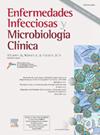SIPrEP: A tool to monitor HIV pre-exposure prophylaxis in Spain
IF 2.5
4区 医学
Q3 INFECTIOUS DISEASES
Enfermedades infecciosas y microbiologia clinica
Pub Date : 2025-10-01
DOI:10.1016/j.eimc.2025.06.007
引用次数: 0
Abstract
Objectives
Pre-exposure prophylaxis (PrEP) has been available in Spain since November 2019 and implemented nationally in 2021. Monitoring the implementation process is essential to optimize the strategy. This manuscript describes the Spanish PrEP Programme Information System (SIPrEP), its methodology, and characteristics of PrEP users from November 2019 to May 2024.
Methods
Nationwide open cohort that collects data on persons ≥16 years who were prescribed PrEP in Spain. The study included participants with public program PrEP prescriptions since November 1, 2019. The project was piloted and fully implemented in July 2020.
Results
By May 2024, 28,798 people received public program PrEP in Spain, and 4159 users were included in SIPrEP. Most were men (99%, n = 4117), primarily gay, bisexual, and other men who have sex with men (GBMSM) (97%, n = 4005), with a median age of 36 years (IQR: 30–43). Most were born in Spain (74%, n = 3075), and 36% (n = 1503) had university education. Referrals came from STI centers (19%, n = 805) and primary care (20%, n = 820). At entry, 8% (n = 348) had syphilis, 7% chlamydia (n = 270) and 7% (n = 300) had gonococcal infection. Among users, 15% (n = 642) discontinued PrEP, and 34% (n = 216) of them restarted later. There were four HIV seroconversions (incidence 0.12/100 person-years [95% CI: 0.05–0.33]).
Conclusions
SIPrEP provides valuable real-world data for optimizing interventions but requires improved national coverage.
SIPrEP:在西班牙监测艾滋病毒暴露前预防的工具
暴露前预防(PrEP)自2019年11月起在西班牙推出,并于2021年在全国实施。监测执行过程对于优化战略至关重要。本文描述了西班牙PrEP项目信息系统(SIPrEP),其方法以及2019年11月至2024年5月PrEP用户的特征。方法收集西班牙≥16岁服用PrEP人群的数据,在全国范围内开展开放式队列研究。该研究包括自2019年11月1日以来服用公共项目PrEP处方的参与者。该项目于2020年7月试点并全面实施。结果截止2024年5月,西班牙共有28,798人接受了公共PrEP项目,4159人被纳入SIPrEP。大多数是男性(99%,n = 4117),主要是同性恋、双性恋和其他男男性行为者(GBMSM) (97%, n = 4005),中位年龄为36岁(IQR: 30-43)。大多数出生在西班牙(74%,n = 3075), 36% (n = 1503)受过大学教育。转诊来自性传播感染中心(19%,n = 805)和初级保健(20%,n = 820)。入组时,8% (n = 348)感染梅毒,7% (n = 270)感染衣原体,7% (n = 300)感染淋球菌。在使用者中,15% (n = 642)停止了PrEP, 34% (n = 216)的人后来重新开始PrEP。有4例HIV血清转化(发病率0.12/100人年[95% CI: 0.05-0.33])。结论ssiprep为优化干预措施提供了有价值的现实数据,但需要提高全国覆盖率。
本文章由计算机程序翻译,如有差异,请以英文原文为准。
求助全文
约1分钟内获得全文
求助全文
来源期刊
CiteScore
2.10
自引率
8.00%
发文量
194
审稿时长
29 days
期刊介绍:
Hoy está universalmente reconocida la renovada y creciente importancia de la patología infecciosa: aparición de nuevos agentes patógenos, de cepas resistentes, de procesos con expresión clínica hasta ahora desconocida, de cuadros de una gran complejidad. Paralelamente, la Microbiología y la Infectología Clínicas han experimentado un gran desarrollo como respuesta al reto planteado por la actual patología infecciosa. Enfermedades Infecciosas y Microbiología Clínica es la Publicación Oficial de la Sociedad Española SEIMC. Cumple con la garantía científica de esta Sociedad, la doble función de difundir trabajos de investigación, tanto clínicos como microbiológicos, referidos a la patología infecciosa, y contribuye a la formación continuada de los interesados en aquella patología mediante artículos orientados a ese fin y elaborados por autores de la mayor calificación invitados por la revista.

 求助内容:
求助内容: 应助结果提醒方式:
应助结果提醒方式:


